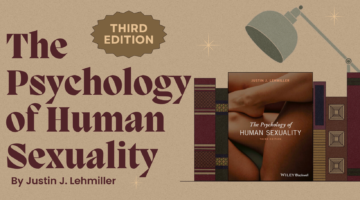The Psychology of Sadism: Why Some People Are Turned On By Others’ Pain
June 17, 2019 by Justin Lehmiller
Sexual sadists are people who derive arousal from inflicting pain on others. This could be physical pain, such as hitting someone else, or it could be psychological pain, such as humiliating another person. Where does this sexual interest come from? A lot of people are curious, including a reader who recently sent me the following question:
“My friend expressed that he is turned on by the idea of seeing someone feel pain and/or discomfort. He said if you want to turn him on, you should whimper or cry. Of course this isn’t his only turn on, but I wonder where it comes from. Why would seeing someone hurt turn him on sexually?”
Before we get into the answer, I think it’s important to start by saying that different people can be drawn to the same sexual interest for very different reasons. In other words, there isn’t just one factor or theory that explains all instances of sexual sadism, or any other sexual interest for that matter. There’s a very complex psychology underlying our sexual attractions.
That said, let’s consider a few possibilities.
One is that, like many other kinks, sadism might be a learned behavior for some people, explainable through the lens of operant conditioning. The basic idea here is that if someone has an experience seeing another person in pain (perhaps they happen to be watching sadistic porn) and this is coupled with very high levels of pleasure (such as a particularly powerful orgasm), this could create an association that would lead this person to try and repeat that experience over and over because seeing others in pain has become psychologically rewarding.
Another possibility is that having certain personality traits might predispose you to developing sadistic interests. What might those traits be? The data I collected for my book Tell Me What You Want offers some insight. I surveyed 4,175 Americans about their sexual fantasies, including fantasies about sadism. When I looked to see what factors sadism fantasies were correlated with, here’s what I found:
· Sadistic fantasies were linked to having an overactive imagination. In other words, people who have “wandering minds” are more likely to report fantasies about others’ pain; however, they’re more likely to fantasize about almost everything else, too! So, sometimes, sadism fantasies don’t mean anything other than that you just happen to fantasize a lot.
· Sadistic fantasies were linked to sensation seeking tendencies. In other words, people who have a preference for thrilling and risky sexual activities are more likely to be drawn to sadism. Of course, sensation seekers are drawn to more intense sexual activities across the board, not just sadism.
· Sadistic fantasies were linked to being less agreeable and having a more avoidant attachment style. In other words, those with sadistic interests reported having less care and concern for the well-being of others, as well as less comfort with emotional intimacy and closeness. Possessing these traits might make it a little easier to imagine inflicting pain on others and to get enjoyment from it.
· Sadistic fantasies were linked to having an unrestricted sociosexual orientation. Put another way, those with sadistic interests tend to see sex and emotion as separate—sex is a less emotional experience for them. Again, this might make it easier for them to picture a scenario in which others are in pain.
· For men (but not women), sadistic fantasies were linked to lower self-esteem, more attachment anxiety (fear of being abandoned), and reports of more sexual problems. This pattern of findings suggests that, for some men, sadistic fantasies may be a way of exerting control that they don’t otherwise feel they have, or perhaps compensating for a perceived deficiency or something they feel is lacking in their own life.
Yet one additional possibility is that what draws people to sadism is actually the same thing that draws people to masochism because sadistic acts are inherently masochistic. In other words, hurting someone else actually hurts you—it’s painful to witness others’ pain—so maybe what turns the sadist on isn’t necessarily someone else’s pain, but their own.
To me, this is perhaps the most fascinating theory. I first had this insight a few years ago when conversing with a professional dominatrix. The description of her work she provided fundamentally changed the way that I think about sadism and masochism because she described this personal pain she experiences when inflicting pain on others. So rather than being two separate sides of a coin, perhaps sadism and masochism go hand-in-hand much of the time. This would explain why a lot of people are “switches,” meaning they go back and forth between adopting sadistic and masochistic roles. It would also explain recent research showing that inflicting pain on others brings emotional pain with it [1].
Let me reiterate that different people may be drawn to sadism for different reasons, which means that there may be some truth to each of the ideas discussed above. In addition, there may be other factors that draw people to sadism beyond those discussed here.
More research is needed to understand the psychological origins of sadism; however, it’s clear that sadism—like all other kinks—has complex roots.
Want to learn more about Sex and Psychology ? Click here for previous articles or follow the blog on Facebook (facebook.com/psychologyofsex), Twitter (@JustinLehmiller), or Reddit (reddit.com/r/psychologyofsex) to receive updates. You can also follow Dr. Lehmiller on YouTube and Instagram.
[1] David S. Chester, C. Nathan DeWall, Brian Enjaian. Sadism and Aggressive Behavior: Inflicting Pain to Feel Pleasure. Personality and Social Psychology Bulletin, 2018; DOI: 10.1177/0146167218816327
Image Source: 123RF/Oleksandr Lypa
You Might Also Like:

Dr. Justin Lehmiller
Founder & Owner of Sex and PsychologyDr. Justin Lehmiller is a social psychologist and Research Fellow at The Kinsey Institute. He runs the Sex and Psychology blog and podcast and is author of the popular book Tell Me What You Want. Dr. Lehmiller is an award-winning educator, and a prolific researcher who has published more than 50 academic works.
Read full bio >


